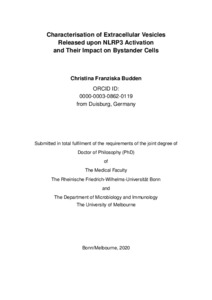Characterisation of Extracellular Vesicles Released upon NLRP3 Activation and Their Impact on Bystander Cells

Characterisation of Extracellular Vesicles Released upon NLRP3 Activation and Their Impact on Bystander Cells

| dc.contributor.advisor | Latz, Eicke | |
| dc.contributor.author | Budden, Christina Franziska | |
| dc.date.accessioned | 2020-04-27T20:41:23Z | |
| dc.date.available | 2022-02-15T23:00:16Z | |
| dc.date.issued | 17.02.2020 | |
| dc.identifier.uri | https://hdl.handle.net/20.500.11811/8330 | |
| dc.description.abstract | Inflammasomes are cytosolic multi-protein complexes that assemble upon detection of danger signals of infectious or sterile origin. Activation of the NOD-like receptor NLRP3 results in activation of caspase-1, which subsequently leads to cleavage and secretion of IL-1β and IL-18, cytokines crucial for inflammation. In addition, NLRP3 activation has also been demonstrated to result in the secretion of extracellular vesicles (EVs). EVs are membraneous compartments, present in almost all body fluids, that derive either directly from the cell membrane (apoptotic bodies and ectosomes) or from multi-vesicular bodies (exosomes). They carry a set of proteins and RNAs distinct from their cell of origin and have been reported to be important mediators of cell-to-cell communication. Within this thesis I show that EVs can be isolated from conditioned tissue culture media most efficiently using a size exclusion chromatography-based protocol. This protocol enriches three distinct EV fractions: large EVs, intermediately sized EVs and small EVs. To investigate the impact of NLRP3 inflammasome activators on all EV subpopulations, THP-1 macrophages were treated with various NLRP3 inflammasome activators or different TLR ligands. All NLRP3 activators are capable of inducing EV secretion, which is primarily NLRP3- and caspase-1-dependent. TLR ligands also induce EV secretion, but in an NLRP3- and caspase-1-independent way. Comparisons of the RNA content of intermediately sized and small EVs show vast differences between the two EV subpopulations, suggesting a regulated loading of cargo into EVs. However, within the same EV subpopulation different NLRP3 activators cause the secretion of a very conserved RNA content, here defined as an EV-associated NLRP3 signature, which is divergent from the RNA content of TLR-induced EVs. Since activation of the NLRP3 inflammasome occurs in various inflammatory diseases, such as gout, atherosclerosis, type II diabetes and mutation- associated auto-inflammatory syndromes, this data may have clinical relevance for biomarker discovery. Additionally, transfer of NLRP3-induced EVs causes the induction of an interferon signature in EV recipient cells. Since interferons are known to counter-regulate inflammasome responses generally and I show here that NLRP3-induced EVs can dampen inflammasome responses in unprimed recipient cells specifically, the EV-induced interferon signature may provide an endogenous mechanism to prevent the induction of a systemic hyper-inflammatory state upon NLRP3 activation. | en |
| dc.language.iso | eng | |
| dc.rights | In Copyright | |
| dc.rights.uri | http://rightsstatements.org/vocab/InC/1.0/ | |
| dc.subject.ddc | 570 Biowissenschaften, Biologie | |
| dc.title | Characterisation of Extracellular Vesicles Released upon NLRP3 Activation and Their Impact on Bystander Cells | |
| dc.type | Dissertation oder Habilitation | |
| dc.publisher.name | Universitäts- und Landesbibliothek Bonn | |
| dc.publisher.location | Bonn | |
| dc.rights.accessRights | openAccess | |
| dc.identifier.urn | https://nbn-resolving.org/urn:nbn:de:hbz:5-57670 | |
| ulbbn.pubtype | Erstveröffentlichung | |
| ulbbnediss.affiliation.name | Rheinische Friedrich-Wilhelms-Universität Bonn | |
| ulbbnediss.affiliation.location | Bonn | |
| ulbbnediss.affiliation.otherLocation1 | Melbourne | |
| ulbbnediss.affiliation.otherName1 | University of Melbourne | |
| ulbbnediss.thesis.level | Dissertation | |
| ulbbnediss.dissID | 5767 | |
| ulbbnediss.date.accepted | 04.02.2020 | |
| ulbbnediss.institute | Medizinische Fakultät / Institute : Institut für Angeborene Immunität | |
| ulbbnediss.fakultaet | Medizinische Fakultät | |
| dc.contributor.coReferee | Bedoui, Sammy | |
| ulbbnediss.contributor.orcid | https://orcid.org/0000-0003-0862-0119 | |
| ulbbnediss.date.embargoEndDate | 15.02.2022 |
Dateien zu dieser Ressource
Das Dokument erscheint in:
-
E-Dissertationen (1939)




